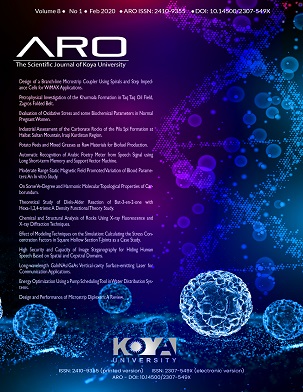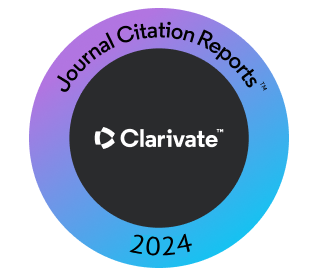Petrophysical Investigation of the Khurmala Formation in Taq Taq Oil Field, Zagros Folded Belt
DOI:
https://doi.org/10.14500/aro.10556Keywords:
Hydrocarbon, Khurmala, Porosity, ReservoirAbstract
The Tertiary rocks of Khurmala Formation in the Taq Taq oil field have been studied using wireline log analysis, drilling cutting descriptions with integration of mud logging report, and test results for understanding reservoir potentiality and fluid distribution. The formation comprised dolostone and dolomitic limestone with an intercalation of clay layers between the recognized beds. The formation has variable thickness throughout the field, 99.8 m from the northeastern limb and 109 m in the southeastern plunge. The calculated shale volume in the studied interval shows a high rate of the clay contents which in some points the gamma ray has 100% of shale. The corrected log-derived bulk porosity subdivided the Khurmala Formation into 5 porosity units from the top to the bottom including (Kh-1, Kh-2, Kh-3, Kh-4, and Kh-5). The first (Kh-1), third (Kh-3), and fifth (Kh-5) porosity units have the average porosity ≥0.10 (10%) that can be considered as good reservoir unit in terms of porosity, whereas the shale contents reduced the reservoir quality of these units. However, well hydrocarbon entrapment through interconnected fractures and fault in the other Tertiary reservoir was recorded in Taq Taq field , but the weak connectivity of the pores in the Khurmala Formation caused this rock interval remains as water bearing zone.
Downloads
References
Adam, A., Swennen, R., Abdulghania, W., Abdlmutalib, A., Hariria, M. and Abdulraheem, A., 2018. Reservoir heterogeneity and quality of Khuff carbonates in outcrops of central Saudi Arabia. Marine and Petroleum Geology, 89, pp.721-751.
Al-Qayim, B. and Othman, D., 2012. Reservoir characterization of an intra-orogenic carbonates platform: Pila spi formation, taq taq oil field, Kurdistan, Iraq. Geological Society, 370, pp.139-168.
Al-Qayim, B. and Rashid, F., 2012. Reservoir characteristics of the albian upper qamchuqa formation carbonates, taq taq oilfield, Kurdistan, Iraq. Journal of Petroleum Geology, 35, pp.317-341.
Al-Qayim, B.A. and Othman, D.H., 2010. Lithofacies association, dolomitization, and potentiality of the pila spi formation, taq taq oil field, Kurdistan region, NE Iraq. Iraqi Bulletin of Geology and Mining, 6(2), pp.95-114.
Ameen, M.S., 1991. Possible forced folding in the taurus-zagros belt of Northern Iraq. Geological Magazine, 128(6), pp.561-584.
Aqrawi, A.A.M., Goff, J.C., Horbury, A.D. and Sadooni, F.N., 2010. The Petroleum Geology of Iraq. Scientific Press, Beaconsfield. p.424.
Asquith, G. and Krygowski, D., 2004. Basic Well Log Analysis. AAPG, Tulsa, Oklahoma. p.244.
Bhuyan, K. and Passey, Q.R., 1994. Clay Estimation from Gamma Ray and Neutron-density Porosity Logs. SPWLA, 35th Annual Logging Symposium, Tulsa.
Dahlberg, K.E., 1989. A Practical Model for Analysis of Compensated Neutron Logs in Complex Formations. SPWLA Annual Logging Symposium, Denver.
Ellis, D.V. and Singer, J.M., 2007. Well Logging for Earth Scientists. Netherlands Springer, Dordrecht.
Garland, C.R., Abalioglu, I., Akca, L., Cassidy, A., Chiffoleau, Y., Godail, L., Grace, M.A.S., Kader, H.J., Khalek, F., Legarre, H., Nazhat, H.B. and Sallier, B., 2010. Appraisal and development of the Taq Taq field, Kurdistan region, Iraq. Geological Society, London, Petroleum Geology Conference Series, 7, pp.801-810.
Ghafur, A.A. and Hasan, D.A., 2017. Petrophysical properties of the upper qamchuqa carbonate reservoir through well log evaluation in the Khabbaz oilfield. Journal of Science and Engineering, 1(1), pp.72-88.
Hollis, C., 2011. Diagenetic on controls reservoir properties of carbonate successions within the Albian turonian of the Arabian plate. Petroleum Geoscience, 17, pp.223-241.
Hollis, C., Lawrence, D.A., Perière, M.D., Al Darmaki, F., 2017. Controls on porosity preservation within a Jurassic oolitic reservoir complex, UAE. Marine and Petroleum Geology, 88, pp.888-906.
Hussein, D., Collier, R., Lawrence, J., Rashid, F., Glover, P.W.J., Lorinczi, P. and Baban, D.H., 2017. Stratigraphic correlation and paleoenvironmental analysis of the hydrocarbon-bearing early miocene euphrates and jeribe formations in the Zagros folded thrust-belt. Arabian Journal of Geosciences, 10, pp.543-554.
Hussein, D., Lawrence, J., Rashid, F., Glover, P. and Lorinczi, P., 2018. Developing Pore Size Distribution Models in Heterogeneous Carbonates Using Especially Nuclear Magnetic Resonance. In: Engineering in Chalk: Proceedings of the Chalk 2018 Conference. ICE Publishing, London. pp.529-534.
Hussein, D.O., 2015. Reservoir Characterization of Ramp Carbonates: Lessons from the Lower Miocene Euphrates and Jeribe Formations, Kurdistan, N. Iraq Doctoral Dissertation, University of Leeds.
Jafarian, A., Fallah-Bagtash, R., Mattern, F. and Heubeck, C., 2017. Reservoir quality along a homoclinal carbonate ramp deposit: The permian upper Dalan formation, South pars field, Persian Gulf Basin. Marine and Petroleum Geology, 88, pp.587-604.
Jassim, S.Z. and Goff, J.C., 2006. The Geology of Iraq. Dolin, Prague. p.341.
Kamel, M.H. and Mabrouk, W.M., 2003. Estimation of shale volume using a combination of the three porosity logs. Journal of Petroleum Science and Engineering, 20, pp.145-157.
Krygowski, D.A., 2003. Guide to Petrophysical Interpretation. Wyoming University, Austin Texas USA. p.147.
Mackertich, D.S. and Samarrai, A.I., 2015. History of hydrocarbon exploration in the Kurdistan region of Iraq. GeoArabia, 20(2), pp.181-220.
Normi, R. and Standen, E., 1997. Middle East Evaluation Well Review.
North Oil Company-Kirkuk (NOC), 1987. Final Well Report of Exploration Well Number 1 in Taq Taq Oil Field.
Rashid, F., Glover, P.W.J., Lorinczi, P., Collier, R. and Lawrence, J., 2015a. Porosity and permeability of tight carbonate reservoir rocks in the North of Iraq. Journal of Petroleum Science and Engineering, 133, pp.147-161.
Rashid, F., Glover, P.W.J., Lorinczi, P., Hussein, D. and Lawrence, J., 2017. Microstructural controls on reservoir quality in tight oil carbonate reservoir rocks. Journal of Petroleum Science and Engineering, 156, pp.814-826.
Rashid, F., Glover, P.W.J., Lorinczi, P., Hussein, D., Collier, C. and Lawrence. J., 2015b. Permeability prediction in tight carbonate rocks using capillary pressure measurements. Marine and Petroleum Geology, 68, pp.536-550.
Rashid, F., Hussein, D., Lawrence, J.A. and Khanaqa, P., 2020. Characterization and impact on reservoir quality of fractures in the cretaceous qamchuqa formation, Zagros folded belt. Marine and Petroleum Geology, 113, pp.104-117.
Rashid, F.N., 2015. The Kometan Formation: Reservoir Characteristics of Tight Carbonates in the Western Zagros Basin. Doctoral Dissertation, University of Leeds.
Rider, M.H. and Kenedy, M., 2011. The Geological Interpretation of Well Logs. Rider-French Consulting Ltd., Sutherland. p.280.
Ryder Scott Company, 2011. Estimated Unrisked Discovered and Undiscovered Total Petroleum Initially in Place Attributable to Certaininterests in the Shaikan License Block, Kurdistan, Iraq. Report Prepared for Gulf Keystone Petroleum Ltd., Iraq.
Schlumberger, 1997. Log Interpretation/Charts. Schlumberger Wireline and Testing, Houston, USA.
Schlumberger, 2012. Definition of porosity: How porosity is measured. Oil Field Review Autumn, 24(3), pp.63-64.
Sherwani, G.H. and Zangana, H.A. 2017. Reservoir characterization of early jurassic formations in selected wells in the duhok governorate, Iraqi Kurdistan region. Journal of Science and Engineering, 1(1), pp.11-18.
Taq Taq Operation Company, 2006. Final Well Report of Development Well Number 5 in Taq Taq Oil Field.
Taq Taq Operation Company, 2007. Final Well Report of Development Well Number 7 in Taq Taq Oil Field.
Van Bellen, R.C., Dunnington, H.V., Wetzel, R. and Morton, D.M., 1959. Lexique Stratigraphique International: 03 10 Asie (Iraq). Paris: Centre National de la Recherche Scientifique Reprinted by Gulfpetro Link, 2005.
Wiley, R. and Pachett, J.G., 1990. CNL (Compensated Neutron Log) Neutron Porosity Modeling, a Step Forward. SPWLA 30th Annual Logging Symposium.
Zebari, M.M. and Burberry, C.M., 2015. 4-D evolution of anticlines and implications for hydrocarbon exploration within the Zagros fold-thrust belt, Kurdistan region, Iraq. GeoArabia, 20, pp.161-188.
Downloads
Published
How to Cite
Issue
Section
License
Authors who choose to publish their work with Aro agree to the following terms:
-
Authors retain the copyright to their work and grant the journal the right of first publication. The work is simultaneously licensed under a Creative Commons Attribution License [CC BY-NC-SA 4.0]. This license allows others to share the work with an acknowledgement of the work's authorship and initial publication in this journal.
-
Authors have the freedom to enter into separate agreements for the non-exclusive distribution of the journal's published version of the work. This includes options such as posting it to an institutional repository or publishing it in a book, as long as proper acknowledgement is given to its initial publication in this journal.
-
Authors are encouraged to share and post their work online, including in institutional repositories or on their personal websites, both prior to and during the submission process. This practice can lead to productive exchanges and increase the visibility and citation of the published work.
By agreeing to these terms, authors acknowledge the importance of open access and the benefits it brings to the scholarly community.
Accepted 2020-01-12
Published 2020-02-20
















 ARO Journal is a scientific, peer-reviewed, periodical, and diamond OAJ that has no APC or ASC.
ARO Journal is a scientific, peer-reviewed, periodical, and diamond OAJ that has no APC or ASC.